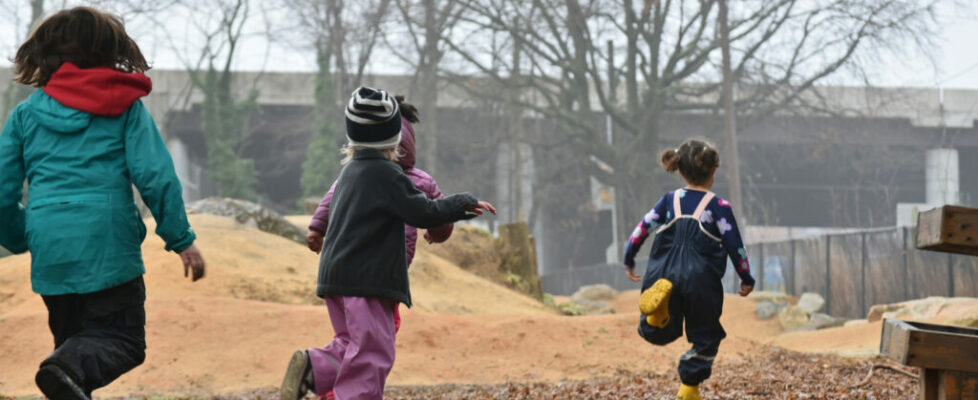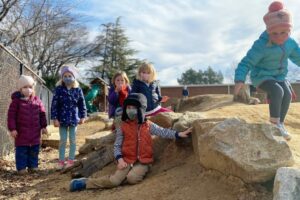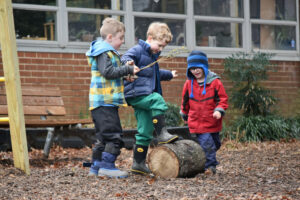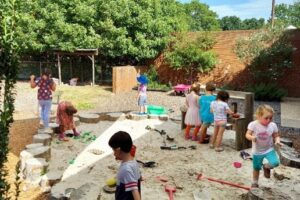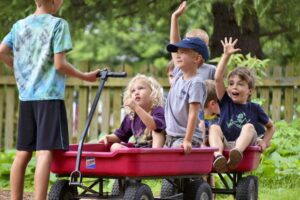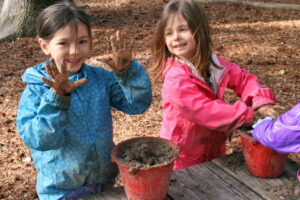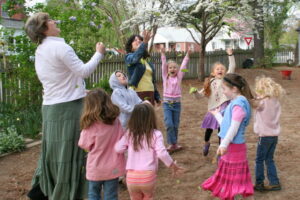Children, Nature, and Play: Scenes from the Early Childhood Program
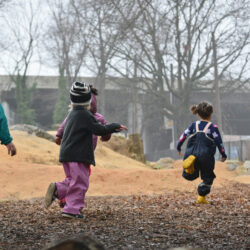
The connection young children feel with nature is innate whether it is with the fluttering butterflies, the delicate yellow blossoms of spring, the mighty oaks, a mud puddle, scampering squirrels or the first snow fall. For young children this connection is easily fostered through their own pure joy and wonder in the ever-changing, dynamic, beautiful living earth. When we observe young children, we can see that they not only want to be in nature, but it is as if they are a part of it or better said, they experience nature as if they are it. We’ve all seen children flap their arms when a bird passes, twirl around when leaves fall, dance like dervishes when the winds pick up and embody a myriad of different animals. As we grow older, the pure joy and wonder is supplemented with our natural curiosity to know more through intellectual understanding.
When children are given the opportunity to form an intimate connection with the earth through consistent self-directed experiences a certain strengthening occurs within them – in their confidence, motor abilities and knowing about the greater cycles of birth and death, of sowing and reaping, of caring for and feasting off of the land and, over time, of creating a relationship with life and all that it offers. In a very basic way, play, exploration, work and contemplation in nature provides children the opportunities whereby a personal relationship with nature can form.
Helping children stay connected to the earth and to the cycles of the year feeds their spirits and calms their minds in ways that are impossible to achieve by other means. Our spirits need to connect with nature for the pure joy of it! It is truly a privilege to witness a child’s accomplishment and sense of efficacy when they have mastered the monkey bars, climbed a tree or jumped the rope 37 times without a miss! In my work with young children, I’ve come to understand how deep a role play, and especially play in nature, has in the healthy development of children.
One day, the kindergarten children were removing small pieces of wood from larger pieces of wood so that they could use the boards to build outside. When a child began using the claw end of the hammer head to try and pry a small board loose, a whole host of earwigs began to scurry from under the wood. Naturally, this set off a commotion with the children. A couple of the children stood up and wanted to run off, but when they saw that I did not, they stayed and sat back down.
Now, to be honest, under my cool exterior, I am not extremely fond of earwigs; however, my purpose in teaching is not to teach the children my likes and dislikes, and especially not my fears. One child said that earwigs are bad and one child killed an earwig. In response to the child’s comment I simply said, “Mother Earth loves all creatures, even the earwigs.” There was a brief pause and the child who killed the earwig said, “I didn’t know Mother Earth loved earwigs.” I said, “Yes, she does.” The little child then said, “I won’t kill them no more.” To this I simply said, “Good.” No moralizing or judgment needed, but rather helping a child maintain a trusting and respectful relationship with the earth.
Children connect with an adult’s authenticity very quickly. They imitate my willingness. Even something as simple as the game, “Ring around the Rosie” turned out to be a lesson for me. One day I decided to really “fall down” as the verse indicates rather than simply bend forward or bend at the knees. The children’s reaction to this was immediate. The way they looked at me is something that is hard for me to put into words. It was almost as if in that moment, they knew that I understood them. It was a real moment. Usually, this game is sung and acted out by small children. That day a big kid played. I was even more accessible to them, yet still their teacher. In my first few years of teaching, I thought that I needed to be serious in order to be an authority or to be “in charge”. Play is teaching me.
Another day I invited the children to roll down a small hill. I instantly had many willing players; however, most did not roll down with abandonment, but were rather timid and watched me. This was a teaching moment. I often model problem-solving skills, perseverance, kindness and patience for the children, but was I also willing to model “fun” for them?
Down I went like a log and for a brief moment I was a rock star. Children who were still on the playground and watching from afar were cheering for me to do it again. Most of the children at the top of hill imitated my roll and came down. A couple of children remained grinning down at me still not quite sure how to start, but an encouraging, “Down you go!” set everyone in motion.
Movements such as running, skipping, rolling, twirling, swinging, jumping, climbing, falling, walking, digging, building, tumbling and biking contribute to healthy proprioception development, motor integration and spatial orientation. Play that combines unstructured movement and nature is crucial not only to the developing brain but also to the emerging spirit of each child.
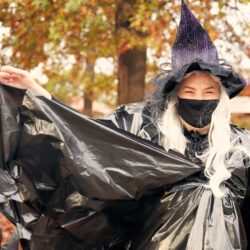 Written by Deborah Boes. Deborah is currently the Early Childhood Department Chair and Lead Teacher in the Magnolia Class. She wrote this article in 2008, and has been providing Waldorf education in our community since 1997.
Written by Deborah Boes. Deborah is currently the Early Childhood Department Chair and Lead Teacher in the Magnolia Class. She wrote this article in 2008, and has been providing Waldorf education in our community since 1997.

